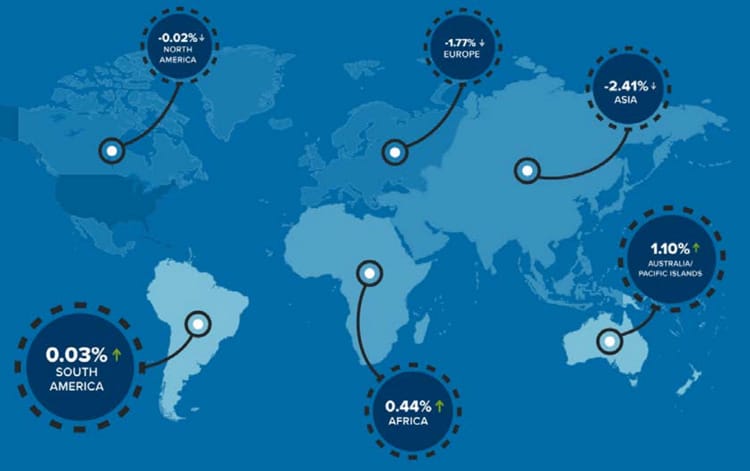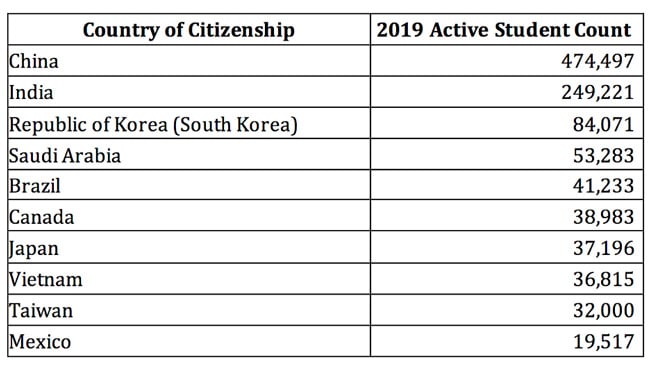US visa data indicates a further decline in foreign enrolment in 2019
- The number of active student visa holders in the US decreased slightly in 2019 compared with 2018
- The most significant decline came from the Asian region, with both Chinese and Indian numbers falling in 2019
The US Department of Homeland Security’s Student and Exchange Visitor Program (SEVP) has released its SEVIS by the Numbers report for 2019, and it reveals a slight decrease in foreign enrolment in the US between the full calendar years of 2018 and 2019. This is a continuation of a trend that’s been going on over the past couple of years, and it echoes the most recent data from the International Institute of Education (IIE) that also showed declining programme enrolments in the 2018/19 academic year.
The information in the SEVIS report is based on data reflecting active student visa holders at all levels of study in the US and provides a comprehensive picture of what’s going on in terms of international enrolment trends across the whole country.
The total number of active F-1 and M-1 student visa holders was 1,523,758 in 2019, down 1.7% (or 27,615 fewer students) from 2018. These students were enrolled in a wide variety of programmes, including primary and secondary schools, higher education, and practical training programmes related to their degrees. However, the vast majority (86%) held visas for higher education programmes at the associate, bachelor’s, master’s, or doctoral levels.
Within higher education, there were:
- 107,312 F-1 students pursuing associate degrees, accounting for 7% of all degrees in which international students were enrolled in 2019 – and numbers were down by 8.1% over 2018;
- 1,011,655 F-1 students working towards either a bachelor's (517,556) or master's (494,099) degree, accounting for 66% of all degrees – and numbers were down by nearly 1%;
- 187,902 F-1 students enrolled in doctoral programmes (12.3% of all degrees) – and in this case, numbers were up by 5.2%.
The top major for international students was second language learning, and the number of visa holders for that major decreased by 6% in 2019. After second language learning, the next most popular majors were business administration and management, computer science, and electrical and electronics engineering.
At the K-12 level, there were 78,366 international students with visas in 2019, the great majority (92%) who were enrolled at the secondary level and nearly half of whom came from China (47%). The next largest sending markets for K-12 schools in the US were South Korea, Vietnam, Mexico and Brazil.
Interestingly, SEVIS also reports a nearly 4% decrease in the number of students participating in optional practical training (OPT) programmes between 2018 and 2019 (140,137 last year as compared to 145,564 in 2018). As we have reported previously, the OPT programme has grown significantly over the past several years, so much so that OPT numbers have been helping to boost overall foreign enrolment numbers in the US over the last couple of years in particular.
Sending markets
The most significant decline in student visa holders recorded in 2019 came from the most important sending region (i.e., as measured by share of students): Asia, where numbers were down by 2.4%. Both China and India sent fewer students in 2019: -4,230 and -2,070, respectively. Even so, 75% of all international students in the US come from Asia.

Europe was also down by 1.8%. Small increases of under 1% occurred for Australia, South America, and Africa. As the SEVIS report explains, “In calendar year 2019, only the continents of Africa (+0.44 percent), Australia and the Pacific Islands (+1.10 percent) and South America (+0.03 percent) saw growth in the number of non-immigrant students studying in the United States. The number of students from Africa increased by 298 student records from calendar year 2018 (67,731) to calendar year 2019 (68,029). The number of students from Australia and the Pacific Islands increased by 110 student records from calendar year 2018 (10,006) to calendar year 2019 (10,116), and the number of students from South America increased by 3,564 student records from calendar year 2018 (118,174) to calendar year 2019 (121,738).”
As the following table reflects, China and India remains far and away the largest sending markets for US institutions and schools.

For additional background, please see:















